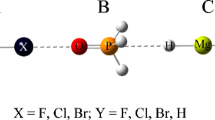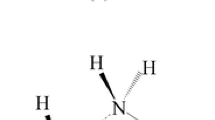Abstract
Halogen bonding, a noncovalent interaction between a halogen atom X in one molecule and a negative site in another, plays an important role in fields as diverse as molecular biology, drug design, and crystal engineering. In this work, the H3N∙∙∙XCN∙∙∙SF2 and H3N∙∙∙XCN∙∙∙SO2 (X = F, Cl, Br, I) complexes are theoretically investigated to find ways to enhance the halogen bond interaction. Cooperative effects are found when X∙∙∙N and S∙∙∙N bonds coexist in the same complex. The ab initio calculations are carried out using at the MP2/aug-cc-pVTZ level, through analysis of surface electrostatic potentials VS(r), interaction energies and the topological analysis based on the quantum theory of atoms in molecules. Particular attention is paid to understand the origin of the X∙∙∙N and S∙∙∙N interactions in the ternary complexes. The cooperativity between both types of the interaction is mainly caused by the electrostatic effects.

Electrostatic potential maps at the 0.001 electron/Bohr3 isodensity surface of isolated SO2 and SF2; black and blue circles are surface maxima and minima, respectively.






Similar content being viewed by others
References
Auffinger P, Hays FA, Westhof E, Ho PS (2004) Halogen bonds in biological molecules. Proc Natl Acad Sci U S A 101:16789–16794
Riley KE, Merz KM Jr (2007) Insights into the strength and origin of halogen bonding: the halobenzene-formaldehyde dimer. J Phys Chem A 111:1688–1694
Triguero S, Llusar R, Polo V, Fourmigué M (2008) Halogen bonding interactions of sym-triiodotrifluorobenzene with halide anions: a combined structural and theoretical study. Cryst Growth Des 8:2241–2246
Jabłoński M (2012) Energetic and geometrical evidence of nonbonding character of some intramolecular halogen∙∙∙oxygen and other Y∙∙∙Y interactions. J Phys Chem A 116:3753–3764
Parker AJ, Stewart J, Donald KJ, Parish CA (2012) Halogen bonding in DNA base pairs. J Am Chem Soc 134:5165–5172
Tsuzuki S, Wakisaka A, Ono T, Sonoda T (2012) Magnitude and origin of the attraction and directionality of the halogen bonds of the complexes of C6F5X and C6H5X (X = I, Br, Cl and F) with pyridine. Chem Eur J 18:951–960
Metrangolo P, Carcenac Y, Lahtinen M, Pilati T, Rissanen K, Vij A, Resnati G (2009) Nonporous organic solids capable of dynamically resolving mixtures of diiodoperfluoroalkanes. Science 323:1461–1464
Jabłoński M, Palusiak M (2012) Nature of a hydride − halogen bond. A SAPT-, QTAIM-, and NBO-based study. J Phys Chem A 116:2322–2332
Aakeröy CB, Fasulo M, Schultheiss N, Desper J, Moore C (2007) Structural competition between hydrogen bonds and halogen bonds. J Am Chem Soc 129:13772–13773
Esrafili MD (2013) A theoretical investigation of the characteristics of hydrogen/halogen bonding interactions in dibromo-nitroaniline. J Mol Model 19:1417–1427
Corradi E, Meille SV, Messina MT, Metrangolo P, Resnati (2000) Halogen bonding versus hydrogen bonding inderiving self-assembly processes. Angew Chem Int Ed 39:1782–1786
Politzer P, Lane P, Concha MC, Ma YG, Murray JS (2007) An overview of halogen bonding. J Mol Model 13:305–311
Clark T, Hennemann M, Murray JS, Politzer P (2007) Halogen bonding: the σ-hole. J Mol Model 13:291–296
Politzer P, Murray JS, Concha MC (2007) Halogen bonding and the design of new materials: organic bromides, chlorides and perhaps even fluorides as donors. J Mol Model 13:643–650
Murray JS, Concha MC, Lane P, Hobza P, Politzer P (2008) Blue shifts vs red shifts in σ-hole bonding. J Mol Model 14:699–704
Politzer P, Murray JS, Concha MC (2008) σ-hole bonding between like atoms; a fallacy of atomic charges. J Mol Model 14:659–665
Riley KE, Murray JS, Fanfrlík J, Řezáč J, Solá RJ, Concha MC, Ramos FM, Politzer P (2011) Halogen bond tunability I: the effects of aromatic fluorine substitution on the strengths of halogen-bonding interactions involving chlorine, bromine, and iodine. J Mol Model 17:3309–3318
Politzer P, Riley KE, Bulat FA, Murray JS (2012) Perspectives on halogen bonding and other σ-hole interactions: Lex parsimoniae (Occam’s Razor). Comput Theor Chem 998:2–8
Murray JS, Lane P, Clark T, Riley KE, Politzer P (2012) σ-Holes, π-holes and electrostatically-driven interactions. J Mol Model 18:541–548
Politzer P, Murray JS (2012) Halogen bonding and beyond: factors influencing the nature of CN–R and SiN–R complexes with F–Cl and Cl2. Theor Chem Acc 131:1114
Politzer P, Murray JS, Clark T (2013) Halogen bonding and other σ-hole interactions: a perspective. Phys Chem Chem Phys 15:11178–11189
Politzer P, Murray JS (2013) Halogen bonding: an interim discussion. ChemPhysChem 14:278–294
Shields ZP, Murray JS, Politzer P (2010) Directional tendencies of halogen and hydrogen bonds. Int J Quantum Chem 110:2823–2832
Riley KE, Hobza P (2008) Investigations into the nature of halogen bonding including symmetry adapted perturbation theory analyses. J Chem Theory Comput 4:232–242
Riley KE, Murray JS, Politzer P, Concha MC, Hobza P (2009) Br∙∙∙O complexes as probes of factors affecting halogen bonding: interactions of bromobenzenes and bromopyrimidines with acetone. J Chem Theory Comput 5:155–163
Politzer P, Murray JS, Clark T (2010) Halogen bonding: an electrostatically-driven highly directional noncovalent interaction. Phys Chem Chem Phys 12:7748–7757
Riley KE, Murray JS, Fanfrlík J, Řezáč J, Solá RJ, Concha MC, Ramos FM, Politzer P (2013) Halogen bond tunability II: the varying roles of electrostatic and dispersion contributions to attraction in halogen bonds. J Mol Model 19:4651–4659
Esrafili MD, Solimannejad M (2013) Revealing substitution effects on the strength and nature of halogen-hydride interactions: A theoretical study. J Mol Model 19:3767–3777
Esrafili MD, Ahmadi B (2012) A theoretical investigation on the nature of Cl∙∙∙N and Br∙∙∙N halogen bonds in F-Ar-X∙∙∙NCY complexes (X = Cl, Br and Y = H, F, Cl, Br, OH, NH2, CH3 and CN). Comput Theor Chem 997:77–82
Esrafili MD, Mohammadirad N (2013) Insights into the strength and nature of carbene∙∙∙halogen bond interactions: a theoretical perspective. J Mol Model 19:2559–2566
Esrafili MD, Juyban P (2014) CNXeCl and CNXeBr species as halogen bond donors: a quantum chemical study on the structure, properties, and nature of halogen∙∙∙nitrogen interactions. J Mol Model 20:2203
Esrafili MD, Mahdavinia G, Javaheri M, Sobhi HR (2014) A theoretical study of substitution effects on halogen–π interactions. Mol Phys 112:1160–1166
Murray JS, Lane P, Clark T, Politzer P (2007) σ‐Hole bonding: molecules containing group VI atoms. J Mol Model 13:1033–1038
Murray JS, Lane P, Politzer P (2008) Simultaneous σ-hole and hydrogen bonding by sulfur- and selenium-containing heterocycles. Int J Quantum Chem 108:2770–2781
Bleiholder C, Werz DB, Köppel, Gleiter R (2006) Theoretical investigations on chalcogen-chalcogen interactions: what makes these nonbonded interactions bonding? J Am Chem Soc 128:2666–2674
Wang WZ, Ji BM, Zhang Y (2009) Chalcogen bond: a sister noncovalent bond to halogen bond. J Phys Chem A 113:8132–8135
Li QZ (2012) Li R, Guo P, Li H, Li WZ, Cheng JB (2012) Competition of chalcogen bond, halogen bond, and hydrogen bond in SCS–HOX and SeCSe‒HOX (X = Cl and Br) complexes. Comput Theor Chem 980:56–61
Bauzá A, Quiñonero D, Deyà PM, Frontera A (2013) Halogen bonding versus chalcogen and pnicogen bonding: a combined Cambridge structural database and theoretical study. CrystEngComm 15:3137–3144
Scheiner S (2013) Detailed comparison of the pnicogen bond with chalcogen, halogen, and hydrogen bonds. Int J Quantum Chem 113:1609–1620
Politzer P, Murray JS (2009) In: Leszczynski J, Shukla M (eds) Practical aspects of computational chemistry. Springer, Heidelberg, p 149
Esrafili MD, Beheshtian J, Hadipour NL (2011) Computational study on the characteristics of the interaction in linear urea clusters. Int J Quantum Chem 111:3184–3195
Esrafili MD, Hadipour NL (2011) Characteristics and nature of halogen bonds in linear clusters of NCX (X = Cl, and Br): an ab initio, NBO and QTAIM study. Mol Phys 109:2451–2460
Solimannejad M, Ghafari S, Esrafili MD (2013) Theoretical insight into cooperativity in lithium-bonded complexes: linear clusters of LiCN and LiNC. Chem Phys Lett 577:6–10
Li Q, Lin Q, Li W, Cheng J, Gong B, Sun J (2008) Cooperativity between the halogen bond and the hydrogen bond in H3N∙∙∙XY∙∙∙HF complexes (X, Y = F, Cl, Br). ChemPhysChem 9:2265–2269
Li QZ, Sun L, Liu XF, Li WZ, Cheng J, Zeng YL (2012) Enhancement of iodine–hydride interaction by substitution and cooperative effects in NCX–NCI–HMY complexes. ChemPhysChem 13:3997–4002
Schmidt MW, Baldridge KK, Boatz JA, Elbert ST, Gordon MS, Jensen JH, Koseki S, Matsunaga N, Nguyen KA, Su SJ, Windus TL, Dupuis M, Montgomery JA (1993) General atomic and molecular electronic structure system. J Comput Chem 14:1347–1363
Peterson KA, Figgen D, Goll E, Stoll H, Dolg M (2003) Systematically convergent basis sets with relativistic pseudopotentials. II. Small-core pseudopotentials and correlation consistent basis sets for the post-d group 16–18 elements. J Chem Phys 119:11113–11123
Boys SF, Bernardi F (1970) The calculation of small molecular interactions by the differences of separate total energies. Some procedures with reduced errors. Mol Phys 19:553–566
Su P, Li H (2009) Energy decomposition analysis of covalent bonds and intermolecular interactions. J Chem Phys 131:014102
Bulat FA, Toro-Labbe A, Brinck T, Murray JS, Politzer P (2010) Quantitative analysis of molecular surfaces: areas, volumes, electrostatic potentials and average local ionization energies. J Mol Model 16:1679–1691
Bader RFW (1990) Atoms in molecules-a quantum theory. Oxford University Press, New York
Biegler-Konig F, Schonbohm J, Bayles D (2001) AIM 2000. J Comput Chem 22:545–559
Bondi A (1964) van der Waals volumes and radii. J Phys Chem 68:441–451
Esrafili MD, Mohammdian-Sabet F, Esmailpour P (2013) Theoretical study on cooperative effects between X∙∙∙N and X∙∙∙carbene halogen bonds (X = F, Cl, Br and I). J Mol Model 19:4797–4804
Esrafili MD, Esmailpour P, Mohammadian F, Solimannejad M (2013) Theoretical study of the interplay between halogen bond and lithium–π interactions: Cooperative and diminutive effects. Chem Phys Lett 588:47–50
Hobza P, Zahradnik R, Muller-Dethlefs K (2006) The world of non-covalent interactions. Coll Czech Chem Commun 71:443–531
Esrafili MD, Behzadi H, Beheshtian J, Hadipour NL (2008) Theoretical 14 N nuclear quadrupole resonance parameters for sulfa drugs: Sulfamerazine and sulfathiazole. J Mol Graphics Modell 27:326–331
Koch U, Popelier PLA (1995) Characterization of C-H∙∙∙O hydrogen bonds on the basis of the charge density. J Phys Chem 99:9747–9754
Author information
Authors and Affiliations
Corresponding author
Rights and permissions
About this article
Cite this article
Esrafili, M.D., Vakili, M. Halogen bonds enhanced by σ-hole and π-hole interactions: a comparative study on cooperativity and competition effects between X∙∙∙N and S∙∙∙N interactions in H3N∙∙∙XCN∙∙∙SF2 and H3N∙∙∙XCN∙∙∙SO2 complexes (X = F, Cl, Br and I). J Mol Model 20, 2291 (2014). https://doi.org/10.1007/s00894-014-2291-8
Received:
Accepted:
Published:
DOI: https://doi.org/10.1007/s00894-014-2291-8




